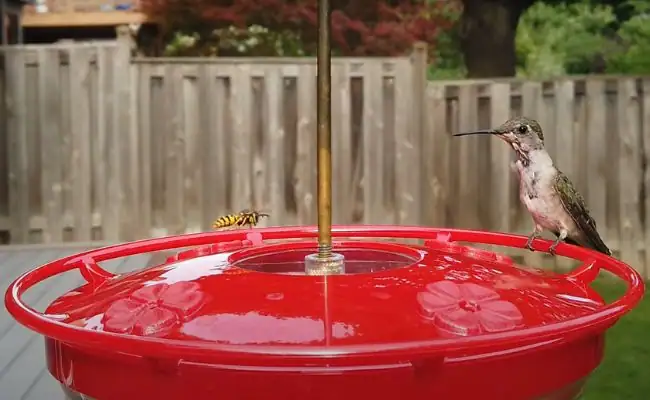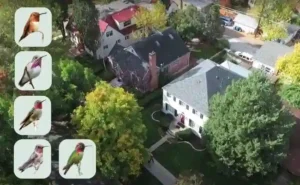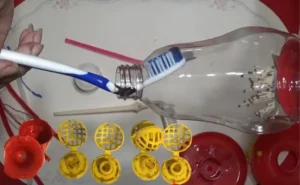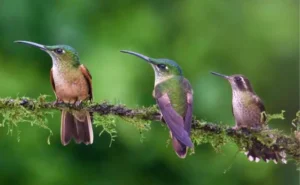Hummingbirds are fascinating little birds with long bills and fast-moving wings. They are seen around nectar feeders throughout summer. They have no sense of smell but they have good color vision. They like especially orange and red colors and are attracted to the sugary water in the red feeders.
However, this sugary nectar also attracts wasps and other insects. They are unwanted guests and these always lead to confrontation. Hummingbirds eat insects but do not eat bees and wasps as the sting is deadly toxic and being stung by them can be fatal.
Wasps have been seen buzzing around the feeder trying to locate the nectar. They try to go through the feeder’s hose to the sugary water inside, so they buzz around the feeder all the time.
These insects love nectar as much as hummingbirds, but these stinging insects generally do not want to share their food. Hummingbird feeders are designed to attract hummingbirds and provide a safe spot for them near their feeders. Wasps can also be attracted to the sugar water in the feeders, which can create problems for the delightful hummingbirds to enjoy with nectar.
Remember, even though wasps can be annoying, they’re still important parts of the ecosystem. We must not hurt them when we try to keep them away but find safe ways to secure nectar for hummingbirds.
Table of Contents
Wasps Are Attracted to Hummingbird Feeders
Wasps, yellow jackets, and hornets are all types of stinging insects in the Vespidae family. They can be attracted to hummingbird feeders in different ways. Firstly, when flowers stop producing nectar due to lack of water or environmental conditions, the insects move to other places in search of nectar.
Among insects, wasps are more aggressive and more attack. When they become too much of a nuisance. Hummingbirds will leave and search for sugary water elsewhere. Wasps prefer flower nectar over feeder sugary nectar but when flower nectar is in short supply, they are desperate and will get sweet liquid from any source.
Secondly, Hummingbird feeders’ yummy nectar attracts these insects. The nectar provides them with carbohydrates for energy, especially wasps and hornets who feed their larvae mainly on protein. These insects like hummingbird feeders because they provide a concentrated nectar source instead of flowers.
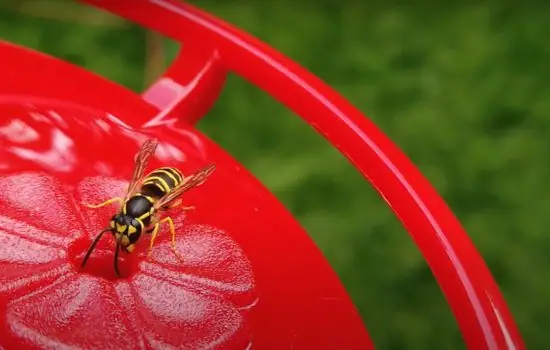
Thirdly, The shape and colors of hummingbird feeders can trick wasps into thinking they’re real flowers. while these insects can be a nuisance around hummingbird feeders. It’s best to try to deter them without harming them.
Wasps Are Harmful To Hummingbirds?
Wasps, yellow jackets, and hornets may attack hummingbird feeders. They hog the feeder, leaving the hummingbirds hungry and frustrated.
- They are dangerous when guarding their food. They may buzz and drive hummingbirds away from the feeder, frustrating them.
- Bacteria and parasites on these insects may pollute feeder nectar. This can make hummingbirds ill, especially those with weak immune systems.
- Although they can sting hummingbirds. A sting on a tiny hummingbird can be fatal, so their presence poses a potential threat.
Keeping feeders pest-free can help hummingbirds eat safely and uninterrupted. If ignored, these insects can reduce hummingbird feeder visits and cause stingings, affecting their health and eating habits.
Effective Ways To Keep Wasps Away From Hummingbird Feeders
Here are some of the effective strategies to help you in keeping wasps away from hummingbird feeders:
- Mint Leaves as Wasp Repellent – You can tie mint leaves around the hummingbird feeder to repel wasps. The strong scent of mint is not appreciated by wasps, making it an effective natural deterrent. Replace mint leaves frequently as they dry out.
- Provide Separate Wasp Feeder – You can provide a decoy feeder for the wasps, yellowjackets, and hornets. Offer a special nectar mix of five parts water and one part sugar. Initially place it close to the hummingbird feeder and gradually move it away daily.
- Strategic Feeder Placement – To strategically place hummingbird feeders away from wasp-prone areas, choose locations with minimal wasp activity.
- Wasp-Repellent Plants – Bees are attracted to yellow flowers. Another way to keep them away from hummingbird feeders is to direct their attention to the pollinated garden full of the sweetest flowers. You can plant mint, basil, and marigolds around the feeders to deter wasps from hummingbird feeders. These plants are known to repel insects without harming them.
- Use Saucer Feeder – One way to keep bees and wasps away from hummingbird feeders is to use saucer feeders, which position the nectar away from the feeding port where long-tongued hummers can reach nectar but insects cannot.
- Modified Feeder Design – Use wasp guards for hummingbird feeders. These features are specifically designed to prevent these insects from accessing the nectar.
- Use the nectar guard tips. The guard tips are placed over the feeder’s holes and the center of the plastic tips is half-closed to prevent wasps from getting to the sugary water. The guard tips are open when a hummingbird stick is built inside and gains access to the sugary water. This disappoints the bees and the wasps from coming.
- Plant Nectarious Flower – You should plant nectarious flowers in your garden to distract the wasps and hornets from the hummingbird feeders.
- Essential Oil Repellents – You can apply peppermint, citronella, or clove oils around the feeder area as these act as natural insect repellents.
- Create Wasp Traps – Set up wasp traps away from feeders to capture and reduce the wasps from hummingbird feeders.
- Regular Cleaning – Always keep the sipping holes clean. You must clean feeders regularly to remove sticky residue that might attract wasps.
- Use Red Colored feeders – Choose feeders with colors like red to be less attractive to wasps. This method can keep yellow jackets away from hummingbird feeders.
- Wipe with Vinegar Solution – Wipe feeders with vinegar and water solution to keep wasps away.
- Tea Tree Oil Application – Apply tea tree oil on cotton balls and wipe it onto feeding stations to repel wasps. It has a strong scent that is overwhelming to wasps. You can also apply the oil on cotton balls and place them near the feeders.
- Alternative Hornet Traps – Use hornet traps with a fruit and sugar water mixture away from hummingbird feeders.
- Use Insect Guards – The use of insect guards, such as water-filled, cup-style moats, can be effective in keeping insects away from certain areas.
- Hang feeders in shade – Placing feeders in shaded locations can help prevent insects from visiting, as they tend to be less attracted to darker, cooler spaces.Wasps prefer to feed in sunlight. They locate the feeders in a new location. The shade will discourage them from visiting. They don’t have as good a memory as the hummingbirds. They will be confused while not finding the feeder and fly away. This enables hummingbirds to enjoy the feeders without any interference from the bees and the wasps.
- A feeder with a small hole opening. A feeder with a small opening will prevent wasps from reaching the sugary water. It’s interesting to see them trying desperately to get inside the small opening and they sometimes fight among themselves. When they are fighting away, the hummingbird is back and drinks with bill and tongue.
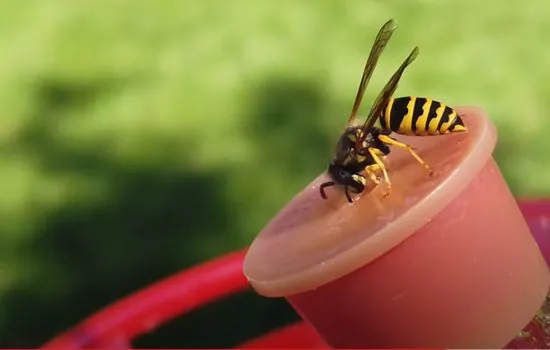
What Not To Do
- Avoid Harmful Deterrents – Don’t use Vaseline, oils, or raids as they can harm hummingbirds. So use natural ways to deter wasps.
- Avoid yellow color – Yellow-coloured hummingbird feeders attract wasps and hornets.
- Avoid Cinnamon in Nectar – Caution against using cinnamon in nectar, as it attracts bees and may also draw wasps.
- Avoid Sweet Spills – Be cautious not to spill sweet nectar when refilling the feeder, as this can attract wasps. Clean any spills immediately.
- Avoid Insecticides – If you are applying insecticides to deter wasps and other insects from your feeders, be mindful while applying and consider potential risks.
- Avoid Spraying Pesticides – If a beehive has been established, avoid spraying near the hummingbird feeders. If there are other hives inside the garden in areas with trees, bushes, or shrubs, apply the insecticide there as well, but be cautious about its intensity.
Conclusion
It’s important to find a balance in controlling pests, recognizing that wasps play a role in the environment. Everybody wants to create a safe space for both hummingbirds and wasps. Avoid harmful things like pesticides to make sure everyone stays safe.
By doing these easy steps, you can enjoy watching hummingbirds without causing harm to wasps and maintain a happy and balanced environment for everyone.

